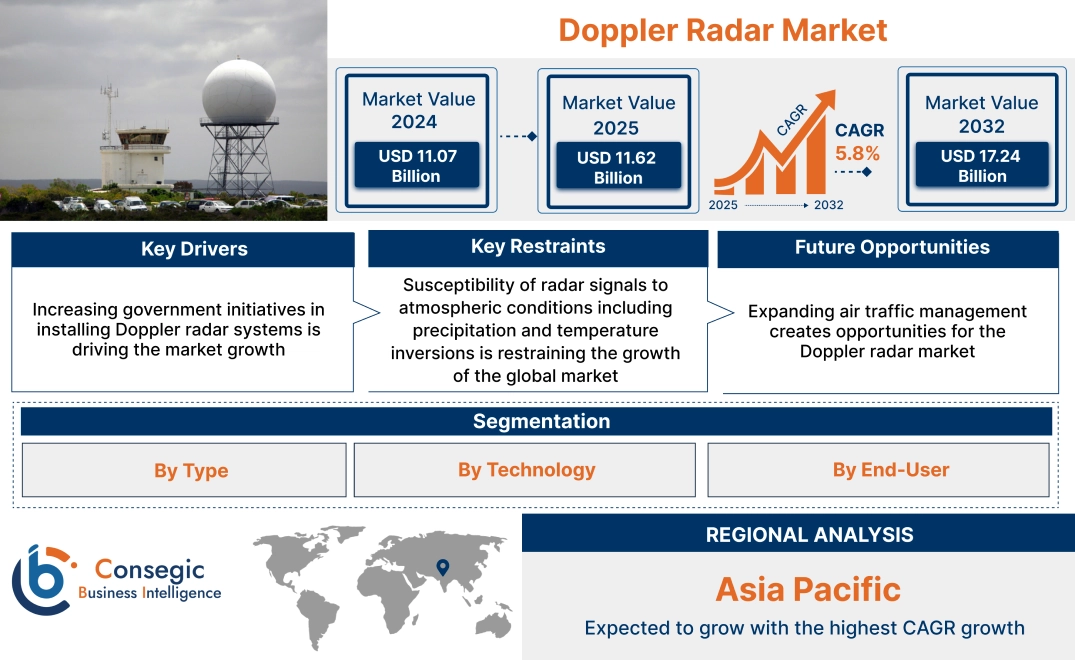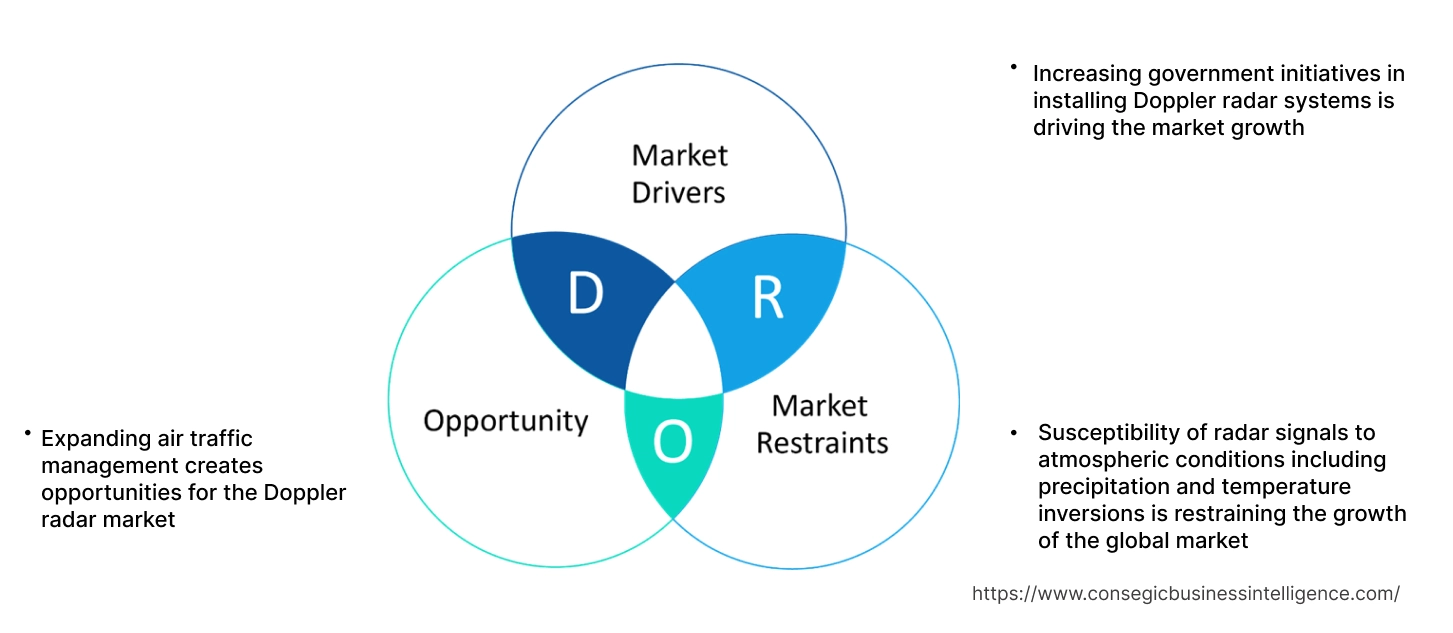- Summary
- Table Of Content
- Methodology
Doppler Radar Market Size:
Doppler Radar Market Size is estimated to reach over USD 17.24 Billion by 2032 from a value of USD 11.07 Billion in 2024 and is projected to grow by USD 11.62 Billion in 2025, growing at a CAGR of 5.8% from 2025 to 2032.
Doppler Radar Market Scope & Overview:
Doppler radar is a specialized type of radar that uses the Doppler effect to determine the speed and direction of objects at a distance. It works by transmitting radio waves toward a target and analyzing the change in frequency of the reflected waves caused by the target's motion. This allows the radar to measure the radial velocity of the target relative to the radar system, providing valuable information for various applications such as weather forecasting, air traffic control, and law enforcement.
Key Drivers:
Increasing government initiatives in installing Doppler radar systems is driving the market growth
Increasing government investment in Doppler radar networks is leading to denser and comprehensive coverage, resulting in more accurate and timely weather forecasts, crucial for public safety, disaster preparedness, and economic stability. Additionally, accurate weather information allows for better planning and execution of disaster response efforts, minimizing damage and saving lives. Moreover, government-funded research and development initiatives in this technology are driving innovation and advancements in the field, leading to more sophisticated and cost-effective systems.
- For instance, in Dec 2024, according to Press Information Bureau (PIB) of India, the Odisha State Government is expected to hand over the building to the India Meteorological Department (IMD) for the Doppler Weather Radar (DWR) at Balasore by March 2025 for the installation and commissioning of the DWR at Balasore will be finalized. The State of Odisha has plans to establish three DWRs in total, with locations in Balasore, Sambalpur, and Bhubaneswar. These DWRs will significantly enhance weather monitoring and forecasting capabilities in the region, providing crucial data for localized thunderstorms, heavy rainfall, and issuing timely warnings for up to 3 hours.
Thus, the increasing investment by the government is driving the Doppler radar market share.
Key Restraints:
Susceptibility of radar signals to atmospheric conditions including precipitation and temperature inversions is restraining the growth of the global market
Rain, snow, and hail scatter and absorb radar signals, reducing their range and accuracy, difficult for weather radars, which rely on accurate measurements of precipitation intensity. Additionally, these atmospheric conditions, where temperature increases with altitude rather than decreases, cause radar signals to refract, resulting in inaccurate measurements and the appearance of false echoes. This is particularly difficult for air traffic control radars, as it interferes with the accurate tracking of aircraft. Moreover, these atmospheric effects significantly degrade the performance of these radars, leading to inaccurate measurements and reduced operational effectiveness. This, in turn, is limiting the market growth, as potential customers are hesitant to invest in technology that is susceptible to such environmental factors.
Thus, as per the Doppler radar market analysis, vulnerability of radar signals to atmospheric conditions is impeding the Doppler radar market growth.
Future Opportunities :
Expanding air traffic management creates opportunities for the Doppler radar market
The expansion of air traffic worldwide is expected to create a significant need for more advanced and efficient air traffic management systems. These radars play a crucial role in meeting this demand by providing accurate and real-time data on aircraft positions, speeds, and altitudes. These radars enable air traffic controllers to maintain constant surveillance of aircraft in their airspace, particularly important as air traffic increases, ensuring that aircraft maintain safe separation distances and preventing collisions. In addition, by providing accurate tracking data, these radars help air traffic controllers optimize flight paths and manage traffic flow more efficiently, reducing delays, saving fuel, and minimizing environmental impact. Furthermore, the transition to NextGen air traffic management systems, which rely heavily on automation, is projected to further increase the Doppler radar market demand. These systems require accurate and real-time data to function effectively, and these radars are a key source of this information.
- For instance, in July 2024, according to International Air Transport Association (IATA), Asia-Pacific airlines continued to lead the global aviation industry, demonstrating robust growth with a 27% year-on-year increase in passenger demand. This surge outpaced capacity expansion by a slight margin, resulting in a higher load factor of 81.6%. The region's strong performance significantly contributed to overall industry growth, accounting for a substantial 42% of the year-on-year increase in global air travel demand.
Hence, based on the analysis the expanding air traffic management sector presents significant Doppler radar market opportunities.
Doppler Radar Market Segmental Analysis :
By Type:
Based on the type, the market is segmented into Pulse Doppler Radar, Ground Based Doppler Radar, Naval Doppler Radar, and Air Borne Doppler Radar.
Trends in the Type:
- The trend towards smaller and more compact naval vessels is driving the demand for miniaturized
- radars to offer improved performance and reduced weight, suitable for installation on smaller ships.
- Ground-based radars are evolving with the integration of advanced technologies such as phased-array antennas, digital signal processing, and artificial intelligence for improving the range and resolution of these radars.
The pulse Doppler radar segment accounted for the largest revenue share in 2024
- Pulse technology is used in intelligent transportation systems (ITS) for traffic flow analysis, speed enforcement, and accident prevention is contributing in Doppler radar market expansion.
- These radars identify the location and characteristics of enemy targets, enabling accurate targeting for weapons systems like surface-to-air missiles (SAMs) and anti-aircraft guns.
- Detects and tracks enemy ships, including surface combatants, submarines (via periscope detection), and small boats beyond the horizon, providing valuable situational awareness and targeting information.
- For instance, in October 2024, the U.S. Navy awarded Leonardo DRS a USD 235 million contract to produce the AN/SPQ-9B radar system. This advanced Pulse radar is designed for ship protection, providing detection and tracking capabilities for both air and surface targets.
- Thus, as per the analysis the capabilities of Pulse Radar, help navies to significantly enhance their ability to detect, track, and engage threats, which in turn, is driving the Doppler Radar market size.
The ground-based segment is expected to register the highest CAGR over the forecast period
- Continuous advancements in technology including the development of dual-polarization technology to distinguish between different types of precipitation (e.g., rain, snow, hail), and the use of phased-array antennas to enable more flexible scanning and tracking capabilities.
- Ground-based radars are increasingly being integrated with other technologies, such as satellite imagery and numerical weather prediction models, to provide a more comprehensive and accurate picture of weather conditions.
- Additionally, the growing adoption of ground-based radars to detect and track objects in deep space is also driving the market size.
- For instance, in Feb 2022, U.S. Space Force awarded Northrop Grumman a USD 341 million contract to develop a Deep-Space Advanced Radar Capability (DARC) system. This ground-based radar system will be used to enhance space domain awareness by detecting and tracking objects in deep space, particularly in geosynchronous orbit. The system will operate 24/7 in all weather conditions, providing critical information to the U.S. military and its allies.
- In conclusion, the aforementioned Doppler radar market trends are expected to continue driving growth in the ground-based doppler radar market size in the coming years.
By Technology:
Based on the technology, the market is segmented into Coherent Pulsed, Continuous Wave, and Frequency Modulation.
Trends in the Technology:
- The use of frequency diversity techniques, such as frequency-modulated continuous-wave (FMCW) radar, is enabling Doppler radars to operate with wider bandwidths and higher resolutions.
- MIMO radar technology is being increasingly adopted in Doppler radar systems to improve performance in terms of range, resolution, and target tracking.
The Coherent Pulsed segment accounted for the largest revenue share in 2024
- Coherent pulsed radars operate over long distances, suitable for applications including air and maritime surveillance, where targets are located far away, driving Doppler radar market expansion.
- Additionally, coherent pulsed radars are specifically designed to measure the Doppler shift of the reflected signal, which is directly related to the target's velocity. This capability is essential for applications like traffic monitoring, where accurate velocity measurements are needed to enforce speed limits and identify potential traffic hazards.
- Furthermore, these radars employ advanced signal processing techniques to filter out unwanted signals, such as ground clutter, allowing the radar to focus on the target of interest and improve the overall signal-to-noise ratio.
- Moreover, the increasing investment in research and development is also contributing remarkably in bolstering the market growth.
- For instance, India has achieved a significant milestone with the establishment of the ST Radar at Gauhati University. Developed by SAMEER, Mumbai, this system operates at 212.5 MHz and utilizes an open configuration with active phased array technology. Additionally, the radar features 576 individual antennas, each with its dedicated T/R module and the innovative design enables coherent pulsed radar operation in DBS mode, delivering high-resolution wind data (speed and direction) with exceptional spatial and temporal resolution.
- Overall, the combination of long-range detection, target velocity measurement, clutter rejection, and research and development are driving the Dopler radar market size.
The frequency modulation segment is expected to register the highest CAGR over the forecast period
- FMCW radars achieve high range resolution, allowing for precise distance measurements and the ability to detect and track multiple targets simultaneously, crucial in applications like automotive radar, where accurate distance and velocity information is essential.
- FMCW techniques require lower power compared to pulsed radars suitable for battery-powered devices and applications where power efficiency is critical.
- FMCW radars are relatively inexpensive to manufacture, especially with the advancement of integrated circuits (ICs) and microelectromechanical systems (MEMS) technology.
- These factors are predicted to contribute to the widespread adoption of FMCW technology across various industries.
By End-User:
Based on the end user, the market is segmented into space, marine, aviation, and military and defence.
Trends in the End User:
- The radar is used to track satellites and determine their precise orbits, enabling precise navigation and collision avoidance.
- These systems are used for ship navigation, collision avoidance, and weather monitoring, enhancing maritime safety.
Military and Defense accounted for the largest revenue share of 36.76% in the year 2024 and is also projected to witness the fastest CAGR during the forecast period
- These radars are crucial components of early warning systems, detecting incoming aircraft, missiles, and drones at long ranges, allowing for timely response and interception.
- They track the movement of aerial targets, providing accurate information about their speed, direction, and altitude, essential for guiding interceptor missiles and fighter jets.
- These radars are used in ground-based air defense systems to detect and track low-flying aircraft and missiles, providing crucial information for surface-to-air missile systems.
- Additionally, the increasing government investments in defense sector is also contributing notably in propelling the market growth.
- Therefore, the aforementioned factors are contributing significantly in accelerating the Doppler radar market share.
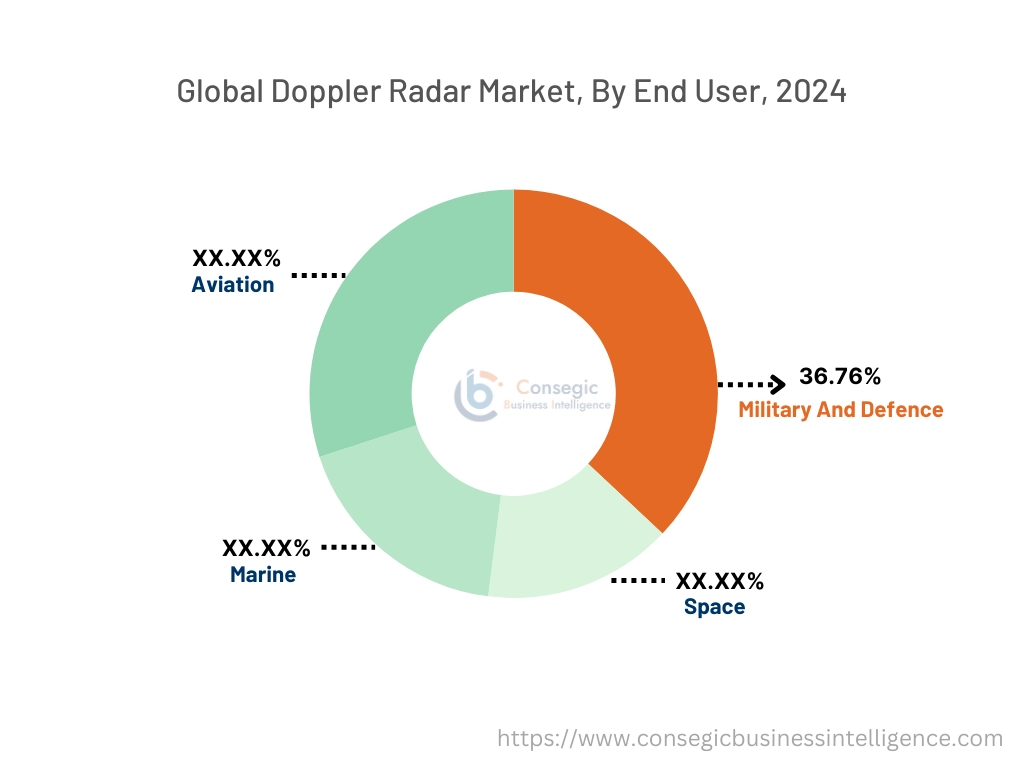
Regional Analysis:
The global Doppler Radar market has been classified by region into North America, Europe, Asia-Pacific, MEA, and Latin America.
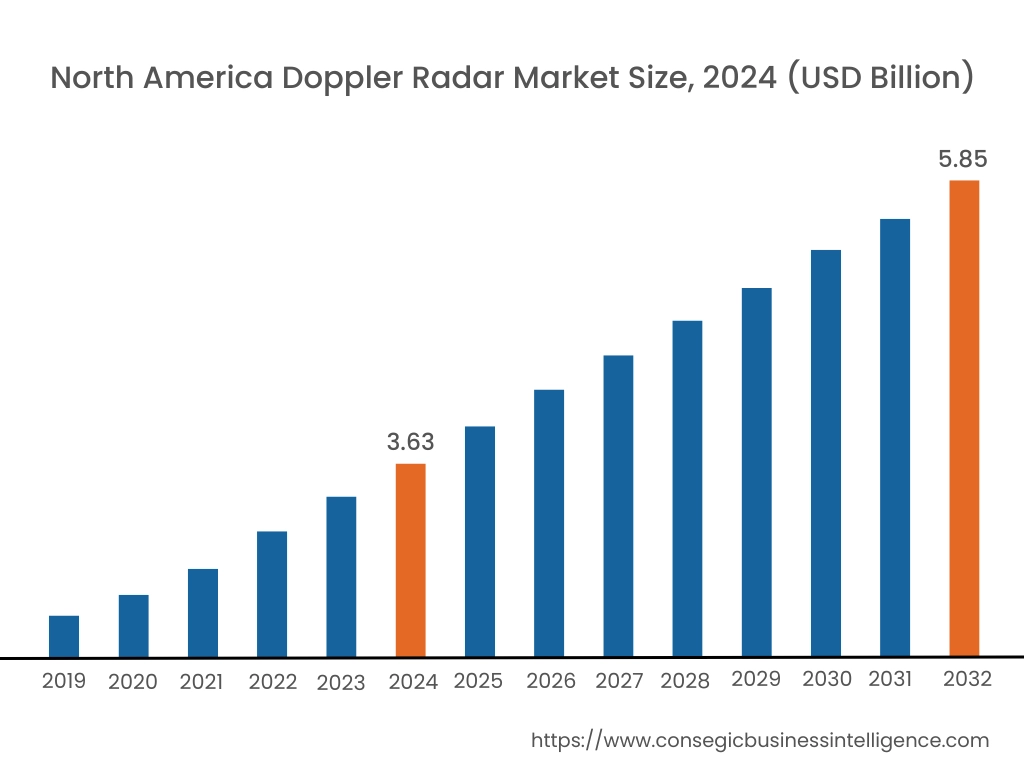
North America region was valued at USD 3.63 Billion in 2024. Moreover, it is projected to grow by USD 3.82 Million in 2025 and reach over USD 5.85 Million by 2032. Out of these, U.S. accounted for the largest revenue share of 78.3% in 2024. The region has strict regulations and standards for weather monitoring and aviation safety, driving the Doppler radar market demand to provide accurate and timely information. Additionally, North America has a well-developed infrastructure for weather monitoring and surveillance, including a dense network of weather radar stations. The existing infrastructure provides a solid foundation for the adoption and deployment of advanced radar systems. Moreover, the increasing government investments in improving the military infrastructure is also bolstering the market growth.
- For instance, the FY 2025 budget request allocates USD 143.2 billion for research, development, testing, and evaluation (RDT&E) in the United States, along with USD 167.5 billion for procurement. The significant investment aims to enhance the nation's military capabilities across all domains, leading to the establishment of stronger, more agile, and modern combat-credible forces.
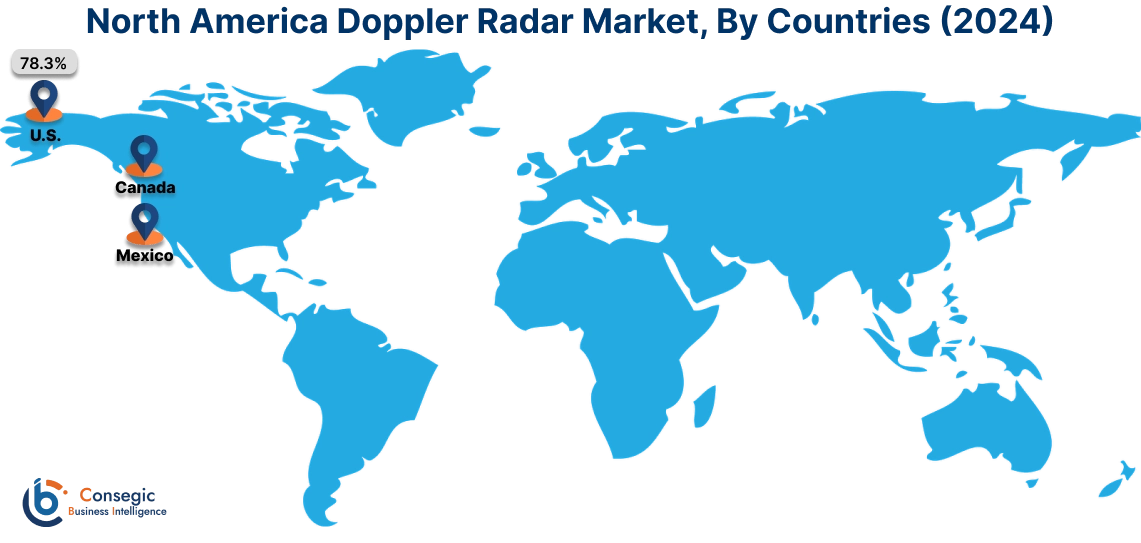
Asia Pacific region was valued at USD 2.86 Billion in 2024. Moreover, it is projected to grow by USD 3.00 Billion in 2025 and reach over USD 4.50 Billion by 2032. Many countries in the Asia Pacific region are experiencing rapid economic growth, leading to increased investment in infrastructure development, including transportation, communication, and energy sectors. This technology is expected to play a crucial role in these sectors for various applications such as air traffic control, weather forecasting, and maritime navigation. Additionally, Asia Pacific region is prone to natural disasters like typhoons, cyclones, and floods. Accurate weather forecasting is crucial for disaster preparedness and mitigation efforts. This technology provides valuable data for weather prediction, enabling early warnings and reducing the impact of natural disasters. In conclusion, the aforementioned factors are contributing notably in boosting the Doppler radar market growth during the forecast period.
As per the Doppler radar market analysis, strict environmental regulations and a focus on sustainable development in Europe are driving the need for advanced weather monitoring and air traffic control systems, which rely heavily on such technology. Moreover, Latin America is highly susceptible to natural disasters like hurricanes, earthquakes, and floods, necessitating robust early warning systems, driving the demand for radar technology for weather forecasting. Furthermore, Middle East & Africa is rich in oil and gas resources, and radar technology plays a crucial role in offshore exploration and production activities.
Top Key Players and Market Share Insights:
The market is highly competitive with major players providing casino management solutions to the national and international markets. Key players are adopting several strategies in research and development (R&D), product innovation, and end-user launches to hold a strong position in the market. Key players in the Doppler radar industry include-
- Continental AG (Germany)
- Echodyne Corp. (U.S.)
- Northrop Grumman (U.S.)
- Arbe (Israel)
- Autoliv Inc. (Sweden)
- Robert Bosch GmbH (Germany)
- Saab AB (Sweden)
- ZF Friedrichshafen AG (Germany)
- Infineon Technologies AG (Germany)
- InnoSenT - Innovative Radar Sensor Technology (Germany)
- Kestrel Radar Sensors (U.K.)
- Lockheed Martin Corporation (U.S.)
- HELLA GmbH & Co. KGaA (Germany)
- NXP Semiconductors (Netherlands)
- Oculii Corporation (U.S.)
- SRC, Inc. (U.S.)
Recent Industry Developments :
Partnerships & Collaborations:
- In, Jan 2024, India Meteorological Department (IMD) announced to establish a comprehensive Doppler Weather Radar network across the country by 2025, adding 25 new radars to improve predictions of extreme weather events.
Doppler Radar Market Report Insights :
| Report Attributes | Report Details |
| Study Timeline | 2019-2032 |
| Market Size in 2032 | USD 17.24 Billion |
| CAGR (2025-2032) | 5.8% |
| By Type |
|
| By Technology |
|
| By End-User |
|
| By Region |
|
| Key Players |
|
| North America | U.S. Canada Mexico |
| Europe | U.K. Germany France Spain Italy Russia Benelux Rest of Europe |
| APAC | China South Korea Japan India Australia ASEAN Rest of Asia-Pacific |
| Middle East and Africa | GCC Turkey South Africa Rest of MEA |
| LATAM | Brazil Argentina Chile Rest of LATAM |
| Report Coverage |
|
Key Questions Answered in the Report
How big is the Doppler Radar market? +
The Doppler Radar Market Size is estimated to reach over USD 17.24 Billion by 2032 from a value of USD 11.07 Billion in 2024 and is projected to grow by USD 11.62 Billion in 2025, growing at a CAGR of 5.8% from 2025 to 2032.
What specific segmentation details are covered in the Doppler Radar report? +
The Doppler Radar report includes specific segmentation details for type, technology, end user, and regions.
Which is the fastest segment anticipated to impact the market growth? +
In the Doppler Radar market, the frequency modulation is the fastest-growing segment during the forecast period.
Who are the major players in the Doppler Radar market? +
The key participants in the Doppler Radar market are Continental AG (Germany), Echodyne Corp. (U.S.), Northrop Grumman (U.S.), Infineon Technologies AG (Germany), InnoSenT - Innovative Radar Sensor Technology (Germany), Kestrel Radar Sensors (U.K.), Lockheed Martin Corporation (U.S.), HELLA GmbH & Co. KGaA (Germany), NXP Semiconductors (Netherlands), Oculii Corporation (U.S.), Arbe (Israel), and Others.
